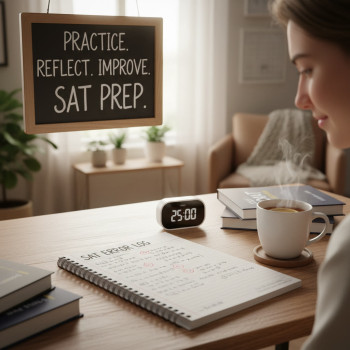What the Non-Calculator Section Is — and What It Isn’t
Let’s start with the obvious: the non-calculator math section is not a nostalgia trip where test-makers punish you for liking technology. It’s a carefully designed slice of the SAT that measures something meaningful — your arithmetic fluency, algebraic thinking, ability to reason quantitatively, and how well you can model problems without relying on a calculator crutch. In plain terms, the College Board wants to know whether you understand numbers, relationships, and methods well enough to solve problems by reasoning and simple computations.
The section feels intense because you have 25 minutes for 20 questions. That’s about 1 minute and 15 seconds per question on average. But the clock doesn’t tell the whole story — smart management of time, the ability to estimate, and knowing which problems to attack immediately versus which to skip are the skills that separate a solid score from a great one.
Core Skills Tested — A Clear Map
Rather than a grab-bag of random calculations, the non-calculator questions cluster into themes. Understanding these categories helps you prioritize practice and spot patterns during the test.
Topic Breakdown (Approximate)
| Topic | Approx. % of No-Calc Section | Skills Tested |
|---|---|---|
| Heart of Algebra | ~40% | Linear equations, systems, manipulation, slope/line interpretation |
| Problem Solving & Data Analysis | ~30% | Ratios, proportions, percentages, rates, interpreting tables and graphs |
| Passport to Advanced Math | ~20% | Quadratics, manipulating expressions, function notation, higher-order algebra |
| Additional Topics (Geometry & Trig) | ~10% | Angles, area, volume, basic trig, coordinate geometry |
These percentages are approximate, but they reflect what you’ll see most often. The non-calculator section emphasizes clean algebraic thinking and number sense more than fancy arithmetic tricks.
Question Types to Expect
- Multiple-choice questions with four answer choices
- Student-produced responses (grid-ins), where you supply the answer
- Questions that reward algebraic manipulation rather than brute calculation
Why Colleges Care About No-Calc Skills
College success isn’t about who can press buttons the fastest. Professors and employers want people who can reason, set up a model, and check it for sense. The no-calculator section is a proxy for that ability: can you translate words into equations, manipulate those equations confidently, and tell whether your answer is reasonable?
Strategies That Work (and Why They Work)
Here’s where the test becomes beatable — not by memorizing answers, but by adopting efficient habits that fit the section’s purpose.
1. Master Mental Math and Smart Paper Habits
Mental math shortcuts save time. Practice multiplying and dividing by 5, 25, 125; halving and doubling; working with simple fractions. But don’t rely on memory tricks alone — write clean, compact work on your scratch paper. Clear notation prevents silly arithmetic mistakes when you’re under time pressure.
2. Use Algebra Before Arithmetic
If an expression simplifies algebraically, do that first. For example, to compute 3(x+4) = 2x+11, you don’t need to know x numerically at first — solve algebraically and keep numbers small. Algebraic simplification often collapses messy arithmetic into neat integers or simple fractions.
3. Plug in Numbers or Back-Solve
Many problems are easier if you substitute convenient numbers or plug in answer choices. If a question gives relationships but no numbers, try a simple number that fits the constraints (like 1, 2, or 10) and work through. For multiple-choice problems, plug in answer choices to see which one satisfies the condition quickly.
4. Estimate to Avoid Unnecessary Work
If the question has four choices, quick estimation can eliminate 1–2 answers immediately. Round numbers and test for magnitude. If your estimate is 47 and choices are 12, 24, 47, 101, you’re done.
5. Recognize When Exact Arithmetic Isn’t Required
SAT often allows you to leave answers in factored forms or simple radicals. Don’t force a long decimal calculation when a fraction or expression is acceptable, especially in grid-in answers where equivalent forms are allowed.
6. Apply Units and Reasonableness Checks
After you solve, quickly check units and ask whether the answer makes sense. A rate question giving hours and miles should have an answer in miles per hour; a negative area is a red flag.
Walkthrough: Sample Problems and How to Think Through Them
Working examples are the best way to learn the non-calculator mindset. Below are representative problems with step-by-step reasoning you could do without a calculator.
Problem 1 — Heart of Algebra (linear equation)
Solve for x: 3(x – 2) = 2x + 5.
How to think: Distribute, collect like terms, isolate x. No heavy arithmetic required.
- 3x – 6 = 2x + 5
- 3x – 2x = 5 + 6
- x = 11
Simple, clean, and typical of many no-calc items. If you make this process automatic, you shave precious seconds.
Problem 2 — Problem Solving (rates)
Two painters working together can paint a fence in 6 hours. One painter working alone takes 10 hours. How long would the second painter take alone?
Why it’s no-calculator friendly: You set up rates as fractions and solve a linear equation.
- Let the second painter’s time be t hours. Their rates: 1/10 and 1/t fences/hour.
- Combined rate: 1/6 = 1/10 + 1/t.
- 1/t = 1/6 – 1/10 = (5 – 3)/30 = 2/30 = 1/15, so t = 15 hours.
Good test of fraction manipulation and algebraic setup.
Problem 3 — Passport to Advanced Math (quadratic reasoning)
If x^2 – 5x + 6 = 0, what is x + 1/x? Approach: Use factoring and properties rather than computing roots numerically.
- Factor: (x – 2)(x – 3) = 0 → x = 2 or x = 3
- Compute x + 1/x for both: For x=2 → 2 + 1/2 = 2.5. For x=3 → 3 + 1/3 = 3.333…
- But if the question asks for a value independent of the root, try to manipulate symbolically: Sometimes the expression simplifies to the same value for both roots. Here it does not, so the test would typically ask for both possible values or something equivalent.
Key idea: Factoring and algebraic shortcuts avoid messy decimal work.
Problem 4 — Geometry (angles and coordinate geometry)
A right triangle on the coordinate plane has vertices at (0,0), (4,0), and (4,3). What’s the length of the hypotenuse? You don’t need a calculator — recognize the 3-4-5 triangle.
Answer: 5. Spotting common Pythagorean triples is helpful and perfectly allowed.
Common Pitfalls and How to Avoid Them
- Rushing into arithmetic: If you start multiplying before simplifying, you’ll waste time and increase error risk. Always simplify algebraically first where possible.
- Overcomplicating grid-in answers: If a fraction is acceptable, give the fraction. Don’t force a long decimal when a simple fraction will do.
- Forgetting to check negative or extraneous solutions: Especially with squared expressions and absolute values, re-check that your solution meets the original equation.
- Ignoring units or context: Word problems often have unit-based clues that guide the right setup.
Timing and Pacing: A Practical Plan
Time management is a skill you build with practice tests. Here’s a practical blueprint for the 25-minute section.
- First pass (10–12 minutes): Answer the easy, straightforward questions. These are usually the ones you can do in under a minute.
- Second pass (8–10 minutes): Attempt medium-difficulty problems — the ones that require a couple of steps or neat algebra.
- Final pass (3–5 minutes): Attempt the hardest questions including grid-ins. If you’re unsure, do a quick estimation or plug in answers; for grid-ins, use a convenient exact value if possible.
Don’t get hung up on any one question. Every minute you spend on a single tough problem is a minute lost that could have been used to secure several easier points.
How to Practice Effectively — Not Just More
Quality trumps quantity. Here’s how to practice so your non-calculator skills actually improve.
Deliberate Practice Steps
- Identify weak topics: Use practice sets to find where errors cluster (fractions, algebraic manipulation, geometry, etc.).
- Drill targeted micro-skills: Spend short, focused sessions on one skill — e.g., solving two-step equations or converting ratios to rates.
- Simulate exam conditions: Time yourself strictly for the 25-minute window and use only scratch paper and pencil.
- Review mistakes slowly: For each error, write why the mistake happened and how to avoid it next time.
Use Smart Tools and Guidance
Personalized help makes a real difference. Working with a coach or an expert tutor helps you identify recurring errors and set an efficient practice plan. For example, Sparkl’s personalized tutoring offers 1-on-1 guidance, tailored study plans, and AI-driven insights that can show which micro-skills to prioritize and how your mistakes evolve over time. When a tutor demonstrates the strategy and watches you apply it, improvement tends to be faster and more consistent.
How to Tackle Grid-In Questions Without a Calculator
Grid-in (student-produced response) questions require you to supply an answer. The rules are forgiving: equivalent forms count, so fractions, mixed numbers, and simplified radicals are all acceptable when correct. Here are tips to handle them under pressure.
- Prefer exact forms: If the answer simplifies to 3/4, enter 3/4 rather than 0.75 unless you’re confident with decimals.
- Use substitution: If the expression is messy, choose small integer values to test or simplify the setup algebraically.
- Double-check format: Know how to fill the grid quickly and avoid misplacing digits.
Exam-Day Checklist for No-Calculator Success
- Practice a calm, consistent scratch-note format: line-by-line workings help avoid confusion.
- Bring a sharpened pencil and an eraser — small comforts count.
- Start with confidence: do the easy questions quickly to secure marks early.
- Keep an eye on the time but focus primarily on effective problem selection.
How Progress Looks Over Time
Your performance usually follows a pattern: initial improvement from technique changes, a plateau as you encounter harder problems, and then a final leap as techniques become fluent. Track accuracy and time separately. Improvement in speed without accuracy is dangerous; accuracy without speed leaves points on the table. Balanced gains in both are the goal.
Sample Weekly Practice Plan (4 Weeks)
This plan assumes you already have baseline familiarity with algebra and geometry.
- Week 1: Focus on basic arithmetic fluency, fraction operations, and algebraic simplification. Do timed 25-minute no-calculator sections twice.
- Week 2: Emphasize Heart of Algebra and Problem Solving — set up equations from word problems and practice rate/ratio problems.
- Week 3: Target Passport to Advanced Math and geometry tricks — factoring, quadratics, area/volume problems, and coordinate geometry.
- Week 4: Take full-length practice tests, review mistakes, and tune pacing. Add a few 25-minute focused sessions to keep no-calculator muscles sharp before test day.
Real-World Context: Why These Skills Matter Beyond the Test
Understanding algebra and number sense is useful in many everyday situations: analyzing trends in data, budgeting, interpreting statistics in news articles, or estimating travel times. The non-calculator section measures the kind of numerical intuition that makes you a better problem-solver in life — not just on paper.
A Final Word: Confidence Built on Practice
The no-calculator math section rewards clarity of thought more than computational horsepower. If you practice the right skills — algebraic manipulation, clean estimation, spotting useful substitutions, and neat scratch work — you’ll find yourself solving questions faster and more accurately. Don’t be afraid to seek guided help if you’re stuck: personalized tutoring, like the kind Sparkl provides with one-on-one guidance and tailored study plans, can accelerate progress by focusing on the specific micro-skills that slow you down.
When you walk into test day, you want to feel like the non-calculator section is where you shine: calm, precise, and fast. With smart practice and the right strategies, it will be.
















No Comments
Leave a comment Cancel